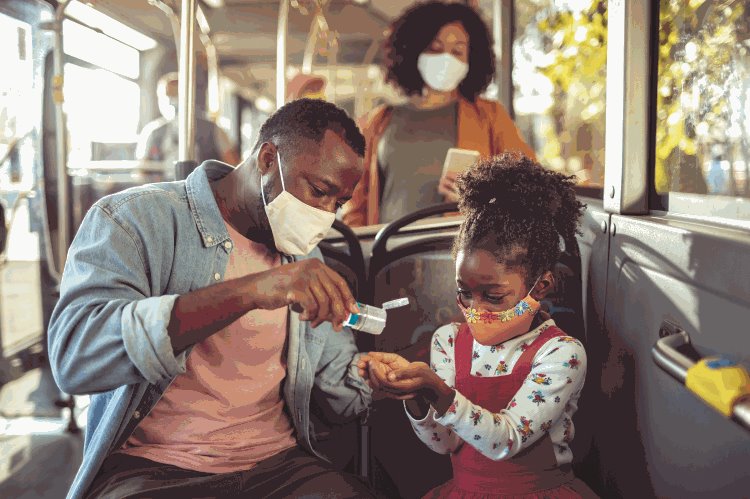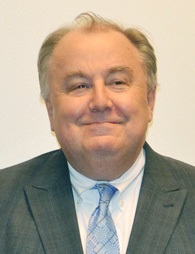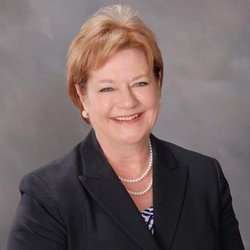Region’s Transit Agencies Respond to Needs of Community; Ready to Welcome You Back

The region’s transit providers are working to keep their riders and employees safe and informed. Riders are
asked to share the responsibility by wearing a mask, sanitizing their hands and doing things to keep
themselves and those around them safe and healthy.
Things are slowly starting to return to normal amid the COVID-19 pandemic, and the region’s public transit agencies remind North Texans that they are prepared to get people where they need to go – when riders are ready.
While ridership was greatly affected by the pandemic, transit has continued to serve an essential function for those who need it to get to work, school and other spots throughout the region. Since the beginning, transit vehicles have provided transportation to healthcare professionals, first responders, service industry professionals, as well as other essential workers. Transit has also helped seniors and people with disabilities who require help getting meals, medicine, necessities and life-sustaining services.
Trinity Metro, for example, provided thousands of paratransit trips to medical appointments and grocery stores in November and December 2020 alone, as well as trips for dialysis treatment.
Dallas Area Rapid Transit (DART) provided transportation for the Methodist Dallas Medical Center’s COVID-19 vaccination event in Dallas in February of this year. The Denton County Transportation Authority (DCTA) used buses to distribute personal protective equipment such as 225,000 masks and hand sanitizer to its Denton social service agency partners to distribute to its clients, while DART, through eight unique programs and several partnerships, helped deliver nearly 200,000 meals and care packages.
These eight programs included such initiatives as paratransit grocery delivery, senior care package delivery, school meal kit delivery and more. DART also supported the Dallas, Garland and Richardson independent school districts by using its buses and vans to deliver more than 75,000 meals to families who normally relied on their schools' food programs.
These are just a few examples of the work the agencies have done to help their communities through the pandemic. Trinity Metro, DART and DCTA have been working to continue providing a safe riding experience.
All three agencies have been following strict cleaning protocols since the pandemic began, and the federal government continues requiring masks on public transit vehicles. There are also dividers between drivers and riders to promote the health and safety of both customers and employees.
Trinity Metro, DART and DCTA signed on to the American Public Transit Association’s “Health and Safety Commitments Program,” signifying their pledge to instill confidence in customers and to protect their health and safety. Public transportation is safe. Studies around the world show no known link between the coronavirus and public transit.
To reassure the community even further, transit providers are working every day to keep their riders and employees safe and informed. Riders are asked to share the responsibility by doing things everyone has become accustomed to since March 2020.
- Wear a mask.
- Wash or sanitize your hands.
- Practice social distancing on board.
- Do not ride when you are ill.
You can even have your fare ready to go or pay through the DART-maintained GoPass app, which riders of all three transit agencies can use. Riders of DART buses, light rail and Dallas Streetcar vehicles are now also able to pay with a contactless credit card, debit card, or a payment-enabled mobile phone or wearable device.Other options are Trinity Metro’s tap card for local daily, weekly, and monthly tickets and DART’s GoPass tap card.
As a key part of the region’s transportation system, public transit is counted on to help move almost 8 million people. The transit agencies are working daily to ensure the vehicles not only run on time but are clean and ready to welcome riders back.
RTC Approves Resolution Calling for 20% Reduction in SOV Trips
North Texas employers continue to welcome back their employees after more than year of many working from home. COVID-19-influenced changes in travel patterns helped lead to less congestion on the roads.
Now that public- and private-sector entities have shown work can be done anywhere, transportation policymakers have a plan to maintain some of the positive impacts of the traffic and commute patterns after the pandemic.
The Regional Transportation Council has approved a resolution encouraging public and private-sector employers to reduce single-occupancy vehicle commuting by 20%.
There are many ways for employers and employees to reach this target. Telecommuting is just one strategy.
Additional travel demand management choices are carpooling/vanpooling, taking transit, biking, walking or working flexible schedules. North Texans can also combine different modes such as biking and public transit. Employers are encouraged to use www.tryparkingit.com, the region’s commute-tracking and ride-matching website, or a comparable site, to help track progress toward the annual target.
The RTC will monitor agencies’ participation and implementation of the program annually. For more information on this effort, visit www.nctcog.org/SOVTripReductionTarget.
Leadership of Women Helps Deliver Margaret McDermott Bridge
A Message From Michael Morris, P.E., Director of Transportation

The Trinity River and its levees in Dallas have long been viewed as a significant divide, bisecting communities and preventing easy access by many to the amenities of downtown Dallas and surrounding neighborhoods.
I had the pleasure recently of attending the ribbon cutting celebration for a transportation element that should begin to change that: the Margaret McDermott Bridge, designed by renowned architect Santiago Calatrava.
You probably recognize the bridge by the twin 340-foot-high white steel arches. But more important than its beauty is what you may not immediately notice. The bicycle-pedestrian lanes adjacent to the lanes of Interstate 30 will make the Margaret McDermott Bridge a gateway that so many Dallas residents need, a human reconnection.
In North Texas, we place a premium on cooperation, and this project represented an opportunity for the community, officials from all levels of government and the private sector to work together to establish a legacy that will last generations. At the ribbon cutting event, listening to the comments from Margaret’s daughter Mary and Mary’s daughter Grace, I was reminded of the importance of women in delivering this project.
First, there was Margaret McDermott herself, who provided the initial funding necessary to secure such a renowned architect to design the signature elements of the bridge.
Mrs. McDermott understood a project that would stitch neighborhoods together and connect them with downtown. She may have provided seed money for the signature elements, but the work done by dedicated professionals at every level of government proved invaluable to the completion of the half-mile span connecting Oak Cliff and west Dallas with downtown.
Keeping with the theme, officials such as former Sen. Kay Bailey Hutchison and current Rep. Eddie Bernice Johnson worked to secure the federal funding to bring the vision to life. Dallas County Commissioner Dr. Elba Garcia maintained strong county support for the project.
In transportation and other industries, projects are completed by doers, who are capable of great things because of the relationships forged as they work tirelessly on behalf of their communities. Former City Manager Mary Suhm and former Assistant City Manager Jill Jordan were team builders, empowering the staff to persevere through the many challenges of a project that stretched longer than any of us wished. Gail Thomas, former president and CEO of the Trinity Trust Foundation, was also integral in making sure the bridge had the necessary support to move forward.
Next came implementation of the vision. The Texas Department of Transportation’s Deputy District Engineer for the Dallas District, Ceason Clemens, oversaw construction. She and her team were asked to help integrate the signature aspects of the bridge into the design of the project. The North Central Texas Council of Governments’ Sandy Wesch helped with permitting and design review; Dallas County Director of Public Works Alberta Blair and Sarah Standifer, assistant director of stormwater operations for the City of Dallas, also played crucial roles. Anita Wilson of the Federal Highway Administration was there for design review and urban engineering.
These strong Dallas leaders illustrated coordination is possible across the various levels of government. While their roles were different, their complementary abilities produced a bridge that serves the needs of a growing region while connecting our past to our future.
Margaret McDermott had the vision. Other influential women made that vision a reality. And generations of Dallas residents, from Grace Cook to those who follow, will benefit from their passion and perseverance to deliver this transformational structure and human-scale amenities, lessening the divide.
In-Person Meetings Key Relationship-Builders, RTC Chair Daniel says
Member Profile Theresa Daniel, Dallas County Commissioner
Theresa Daniel thought about the challenges she and the Regional Transportation face as they continue to navigate the COVID-19 pandemic. Meetings have continued to lead to productive outcomes since March 2020, when they shifted to the virtual environment. But there’s something missing, which Daniel is excited to recapture.

Dallas County Commissioner Theresa
Daniel was elected RTC chair in June.
“Virtual meetings limit that relationship development,” she said. “I think one of the things I enjoyed the most … was the 10 minutes before the meeting and 10 minutes after the meeting, when you had the opportunity to talk to people you may not normally come in contact with.”
These conversations would sometimes help Daniel realize her colleagues were working on similar projects and that they could help one another. Such networking is made more challenging by the pandemic.
As Dallas County’s Precinct 1 commissioner, Daniel represents residents of parts of Dallas, Richardson, Garland and Mesquite. And she can witness the impact significant projects have on people’s lives.
“I enjoy doing something that makes a difference because I can see physically what’s going on and what that means to communities, to families,” she said.
She pointed to the project to extend the Northaven Trail, an eight-mile, bicycle-pedestrian trail, across US Highway 75 near the boundary separating her Precinct 1 and Precinct 2.
This project “is huge when you think of your common image of what a trail is and that we are connecting two sides of the county that have a difficult time making that link, that bridge across,” she said.
As chair of the Regional Transportation Council, Daniel uses communication as her bridge. She must set a tone that allows 44 members, all representing different portions of the region, to come together to accomplish a common goal – moving transportation forward.
Before transitioning to county government, Daniel, who earned a doctorate in public policy and public administration in 2002 from the University of Texas at Arlington, worked in education, most recently as a project manager in evaluation and accountability with the Dallas Independent School District. She also served as an adjunct professor at the University of Texas at Arlington. Although she dealt with numbers and analysis a lot, what she recognized most was the importance of people and relationships.
“Bottom line to all of this is it’s very people-oriented work, even though you may be working with numbers and metrics and that kind of stuff,” she said. “If you ever forget that you’re working with people, then you’ve already lost.”
Leadership and problem-solving require clear communication.
After completing her master’s degree in social work and urban studies in 1980, she worked as a staffer for former Congressman Martin Frost, which gave her an up-close view of the implementation of policy. The lessons she learned there have helped her in each subsequent job. Relationships. Delivering services.
“It’s also where policies become implemented,” she said.
Transportation affects every aspect of life. From education to grocery shopping, traveling to work to moving merchandise, the transportation system is at the center.
Congestion continues to be one of the most significant issues the RTC deals with – whether its longer trips connecting people to other regions or trips within Dallas-Fort Worth, she said.
One project that could have a significant impact on system reliability is LBJ East.
But, for Daniel, it goes deeper than lessening congestion.
“It’s an equity issue,” she said. “If you have 635 West being much more efficient than it had been previously, this is a continuation of that so that in fact we’re [creating] a greater linkage. And it’s one that will eventually be able to be made seamlessly.”
From the study of high-speed transportation to driverless cars to traditional transportation matters, planners are working on a variety of issues as they try to move the region forward in the face of continued growth.
COVID-19 has required flexibility across the board, while providing an opportunity to assess how things can be accomplished more efficiently.
“If we can’t do it this way because of the health crisis, what are our options?” she said. “What are better options to accomplish the same goals?”
Daniel looks forward to the resumption of in-person RTC meetings.
When COVID-19 required the RTC and other agencies to stop meeting in person, technology filled the void, allowing business to continue. But the pandemic has also shown policymakers the value of being in the same room.
“If it’s just a transference of information, you could send out a PowerPoint and maybe achieve the same results,” she said. But I think that we want a greater outcome, which is, building relationships so that those conversations today are a step up for the next projects coming up on our agenda.”
NASA, NCTCOG Team up to study Drones and Air Taxis
In Dallas-Fort Worth, there is a growing need to explore new technologies and alternatives to move people and goods and limit congestion. The North Central Texas Council of Governments is examining that potential through its new agreement with NASA. NCTCOG and a group of public- and private-sector partners will study cargo-carrying drones and automated air taxis during a series of at least four future workshops.
NASA has been engaged with the Federal Aviation Administration and other regions about how to integrate Advanced Air Mobility technologies such as drones into metropolitan areas. Planning sessions will take place in Dallas-Fort Worth and four other locations across the country through the summer of 2022, each including a series of at least four workshops where experts from the localities and NASA’s Advanced Air Mobility mission will update local plans and create new plans that might be needed to enable AAM.
NCTCOG is one of five selected state and local government entities to have signed agreements with NASA’s aeronautical innovators. In addition to NCTCOG, the Massachusetts Department of Transportation, Minnesota Department of Transportation, Ohio Unmanned Aircraft Systems Center of the Ohio Department of Transportation and the City of Orlando, Florida, have agreed to work with NASA on similar projects.
Drones are becoming more common in our everyday life, from use in business, public safety and for recreational purposes. According to the FAA, there are approximately 870,000 registered drones in the US. Commercial drones make up 44% of the market, while recreational drones make up 56%.
NCTCOG has taken the lead in North Texas to explore the drone industry and study the industry's growth and expansion. Through partnerships with industry experts, NCTCOG has convened the North Texas Unmanned Aircraft Systems (UAS) Safety and Integration Task Force in response to the region's growth. The task force is designed to help mitigate reckless UAS operations and promote the safe integration of UAS technology into the DFW regional airspace. NCTCOG’s UAS Safety and Integration Task Force have organized regularly occurring UAS workshops, UAS working group meetings and other planning activities.
The NASA workshops will also focus on plans for public acceptance, infrastructure, operations and local regulations, as well as evaluating criteria to use in locating “vertiports” for vertical takeoff and landing.
A major goal for these agreements is to develop a best practices document around a key topic that other states and municipalities might follow in developing their plans for integrating AAM into their transportation systems. More specifically, NASA will share with partners what it has learned so far about the challenges associated with planning for and safely operating new types of aircraft and the ways to approach solving those challenges.
NCTCOG Partnering with Schools to Address Future Growth

NCTCOG has published a report with tools to help school districts build partnerships
with local transit agencies. This report includes details of how to engage in effective
coordination including identification of barriers and strategies to overcome them.
Dallas-Fort Worth has been growing rapidly for decades, with a current population of almost 8 million people. This growth is expected to continue, with a forecast population of over 11 million people by 2045. The region’s schools will shoulder a great deal of growth and must find ways to support a continuously expanding student population. Options include constructing new buildings, renovating existing ones and creating partnerships with other entities for the most efficient use of resources.
In spring 2021, NCTCOG’s Sustainable Development Team published School District - Public Transit Coordination in the Dallas-Fort Worth Region, a report that provides tools to help school districts build partnerships with local public transit agencies for student transportation. This report highlights the following:
- Benefits, types and current barriers to coordination
- Strategies and techniques to overcome identified barriers
- Coordination and partnership activities between school districts and transit agencies in Dallas, Denton and Fort Worth
The report was funded by a federal Transportation Infrastructure Generating Economic Recovery (TIGER) grant awarded in 2014. The grant had four goals:
- Encourage interagency cooperation
- Address land use-transportation problems and school siting
- Plan for transportation safety in school locations
- Plan for transportation options and accessibility
Each goal was addressed with resources that cities, agencies and school districts can use to learn about strategies and tools, strengthen local partnerships and learn from other local examples. In addition to the 2021 school district/public transit coordination report, these resources include Planning for Community-Oriented Schools: A Guide to School Siting in North Texas (2017), as well as a series of memos addressing coordinating regional demographics for schools planning, state legislation related to school siting, and land banking programs for schools planning.
The grant additionally funded the creation of three Safe Routes to School (SRTS) plans. Plans were created for Ignacio Zaragoza Elementary in Dallas; James F. Delaney Elementary and James A. Arthur Intermediate School, in Kennedale; and Applied Learning Academy and International Newcomer Academy in Fort Worth. These SRTS plans were created in collaboration with the school staff, city staff and other local partners. SRTS plans can increase the competitiveness of applications for grants such as the federal Transportation Alternatives program for bicycle and pedestrian safety improvements.
For more information and to access all reports and resources, visit www.nctcog.org/saferoutestoschool and www.nctcog.org/schoolsiting.
Images provided by Getty Images, NCTCOG and Dallas County